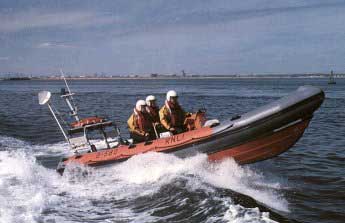History - The new Era
On 26th August 1989 Ian Readman, the Honorary Secretary of the Redcar Lifeboat station monitored a radio message that the fishing vessel Gang Warily had fouled her nets and was being driven ashore under Huntcliff cliffs. Contacting Tyne Tees Coastguard he asked them to activate the pagers for the Redcar lifeboat, and at 2051 the Atlantic 21 Lord Brotherton, then on relief duty at Redcar, was launched.
The lifeboat encountered a NE Force 6 to 7 wind with heavy driving rain and poor visibility. Once clear of the shelter close inshore the Atlantic met large confused and breaking seas which frequently filled the boat and made constant attention to the helm and throttles essential.
Very little could be seen from the Atlantic 21 in the driving rain and spray until, three quarters of a mile from the casualty, the blue flashing light of the coastguard’s LandRover could be seen on the cliff top, marking the position of the casualty at the base of the cliffs below.
 The Atlantic came as close as she dared without entering the breaking seas, and by the light of parachute flares the crew could see the fishing vessel aground on rocks under the sheer 300ft cliffs. The rocks cover at high water and there was no way for survivors to climb the cliffs. With the strong wind from the sea and breaking seas over a large area there was no direct way to the casualty, so Helmsman Thompson anchored and veered down to the fishing boat.
The Atlantic came as close as she dared without entering the breaking seas, and by the light of parachute flares the crew could see the fishing vessel aground on rocks under the sheer 300ft cliffs. The rocks cover at high water and there was no way for survivors to climb the cliffs. With the strong wind from the sea and breaking seas over a large area there was no direct way to the casualty, so Helmsman Thompson anchored and veered down to the fishing boat.
The lifeboat’s searchlight picked out a survivor on the rocks, and it was as obvious that help had to come from seaward, and that the rescue had to be completed before the tide covered the rocks. It was impossible to go closer than 120ft from the casualty so Peter Hodge volunteered to swim ashore with a line.
Half swimming, half swept by the seas, he reached the shore and found both crew men from the casualty. He held them tightly as the lifeboat crew hauled them back to the lifeboat. The time was 2130 and the Teesmouth Tyne class lifeboat had arrived, using her searchlight to illuminate the scene.
When only some 45ft from the lifeboat the line snagged and all three men were pulled underwater. Peter Hodge was held underwater by the line around his waist, but he managed to release the survivors who were washed back ashore. He freed the line and was also washed ashore.
 With only three crew members left aboard the Atlantic, Helmsman Thompson did not want to put another man ashore, so it was agreed that the Tyne class should make an attempt. The crew of the Tyne class prepared their small inflatable ‘X’ boat and Michael Smithson was transferred from the Atlantic 21 to assist aboard the Tyne class.
With only three crew members left aboard the Atlantic, Helmsman Thompson did not want to put another man ashore, so it was agreed that the Tyne class should make an attempt. The crew of the Tyne class prepared their small inflatable ‘X’ boat and Michael Smithson was transferred from the Atlantic 21 to assist aboard the Tyne class.
Once run ashore, the three men - Peter Hodge and the two men from the casualty - climbed aboard the inflatable. The heavily laden small boat was pulled back through the seas rather than over them, but the manoeuvre was successful and the inflatable was brought alongside the lifeboat so that the three men could be pulled aboard - a task accomplished at 2213.
Both lifeboats then moved outside the surf line to stow gear and transfer Michael Smithson back to his own lifeboat ready for the passage back to station. By 2240 the survivors had been landed by the Tyne class and the Lord Brotherton returned to Redcar.
Helmsman Rodney Thompson and Crew Members Peter Hodge, Mark Reeves and Michael Smithson of the Redcar lifeboat were awarded the Thanks of the Institution inscribed on Vellum for their part in the rescue of two men from the fishing vessel Gang Warily.
The divisional inspector of lifeboats for the East division, Mr Tom Nutman, said that the service was carried out in conditions that were on the upper limit for an Atlantic 21 with the lifeboat only inches away from the rocks and potential disaster. He praised Peter Hodge for his great personal bravery in entering the heavy breaking seas.